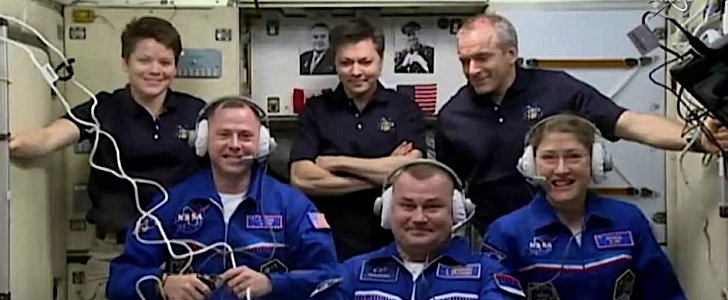Back in October 2018, American astronaut Nick Hague and Russian cosmonaut Aleksey Ovchinin became the unwilling heroes of a Soyuz rocket launch went bad. It took the two men nearly half a year to get back onboard a Russian space capsule and reach their destination, the International Space Station (ISS).
Officially, the mid-flight abort of MS-10 was caused by the first stage of the rocket impacting the second one during separation. The abort took place at an altitude of 50 km (31 miles), and it took the two men nearly 20 minutes of struggling to get the craft back on Earth safely.
The problem that prevented Hague and Ovchinin from reaching the ISS seems to have been fixed, as no incidents were reported since. Also, the two men seem not to have been discouraged by their ordeal.
On March 14, a Soyuz capsule called MS-12 safely docked with the ISS, getting Hague, Ovchinin and Christina Koch on the station for crucial research and science missions.
With the three people sent up on Thursday, the ISS crew now comprises six members, the usual number of occupants for each of the Expeditions. The people already there are NASA’s Anne McClain, Canadian David Saint-Jacques and Russian commander Oleg Kononenko.
The three who launched this week will spend six months orbiting Earth and are tasked with completing 250 experiments in biology, Earth science, human research, physical sciences, and technology development. 75 of these experiments have never been attempted before.
During their stay, the crew will be resupplied by three spacecraft, a Russian Progress, a Northrop Grumman Cygnus and a SpaceX Dragon. They will also conduct three spacewalks, one of which will be the first-ever spacewalk done by an all-female party.
What’s more important is that this crew will be the one to welcome astronauts flying up in the first American-made spacecraft since the retirement of the space shuttles almost a decade ago.
Officially, the mid-flight abort of MS-10 was caused by the first stage of the rocket impacting the second one during separation. The abort took place at an altitude of 50 km (31 miles), and it took the two men nearly 20 minutes of struggling to get the craft back on Earth safely.
The problem that prevented Hague and Ovchinin from reaching the ISS seems to have been fixed, as no incidents were reported since. Also, the two men seem not to have been discouraged by their ordeal.
On March 14, a Soyuz capsule called MS-12 safely docked with the ISS, getting Hague, Ovchinin and Christina Koch on the station for crucial research and science missions.
With the three people sent up on Thursday, the ISS crew now comprises six members, the usual number of occupants for each of the Expeditions. The people already there are NASA’s Anne McClain, Canadian David Saint-Jacques and Russian commander Oleg Kononenko.
The three who launched this week will spend six months orbiting Earth and are tasked with completing 250 experiments in biology, Earth science, human research, physical sciences, and technology development. 75 of these experiments have never been attempted before.
During their stay, the crew will be resupplied by three spacecraft, a Russian Progress, a Northrop Grumman Cygnus and a SpaceX Dragon. They will also conduct three spacewalks, one of which will be the first-ever spacewalk done by an all-female party.
What’s more important is that this crew will be the one to welcome astronauts flying up in the first American-made spacecraft since the retirement of the space shuttles almost a decade ago.
Five months after being forced to abort his first launch to space, @AstroHague is now where he’s destined to be: aboard the @Space_Station. During his 6.5 month mission, he will perform the first spacewalk of his career, conduct experiments & more. Watch: https://t.co/ZuxLDtzW9c pic.twitter.com/lNcVe101M6
— NASA (@NASA) 15 martie 2019

